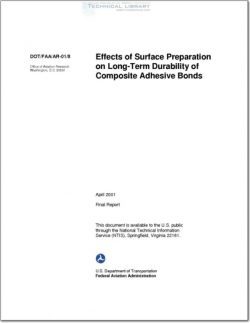DOT-FAA-AR-01-08

- Version
- 269 Downloads
- 1.18 MB File Size
- 1 File Count
- August 16, 2016 Create Date
- August 16, 2016 Last Updated
Effects of Surface Preparation on Long Term Durability of Composite Adhesive Bonds

The long-term durability of adhesively bonded composite joints is critical to modern aircraft
structures, since the use of bonding is increasing as an alternative option to mechanical fastening.
The effects of the surface preparation of the adherends are major durability factors that need to be
characterized. In this study, several potential factors are evaluated, with concentrations on the
effects of chemical contamination from peel ply release agents (silicone and siloxane in this
work) and the chemical and mechanical effects of grit blasting on the fracture toughness and
failure mode of adhesively bonded composites joints.
There are several test methods used to evaluate adhesive bonds, but the large majority tend to
concentrate on bonded metals. An evaluation of the floating roller peel test configuration was
performed, using composite in place of metallic adherends, with the objective of extracting
quantitative data from this commonly used quality control test method. It was found that, for the
range of available sample thicknesses, the brittle behavior and low failure strains of composites,
relative to most metals, hampered this test.
Subsequently, an alternate form of the Double Cantilever Beam (DCB) test was developed.
Based on three different American Society for Testing and Materials (ASTM) standards, this
version was oriented toward adhesively bonded composites, a configuration not found in the test
standards. This test method was used for a sequence of test evaluations. The results of this
research are geared towards aiding the interpretation of a form of the wedge test where the usual
aluminum adherends are substituted by composite adherends. This wedge test will utilize the
same adherends as for the DCB test, thereby simplifying evaluation and comparison. An
alternate version of the test, where the wedge is driven slowly by a motor to a series of fixed
positions, instead of inserted and left in place, is also under evaluation.
Two different data reduction methods were used for analyses, one based on strain energy and the
other on beam theory. Both techniques produced nearly identical results, and an investigation
into cantilever beam compliance results confirmed the use of optical readings of hand—drawn tick
marks as a consistent crack measurement method.
| File | Action |
|---|---|
| DOT-FAA-AR-01-08 Effects of Surface Preparation on Long Term Durability of Composite Adhesive Bonds.pdf | Download |
Comment On This Post